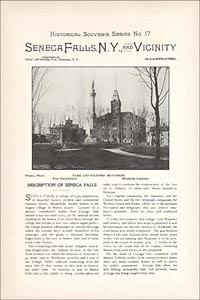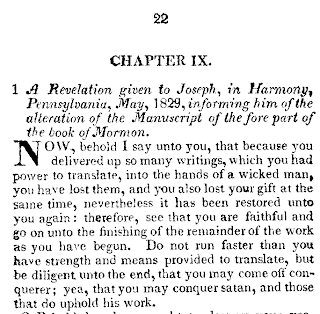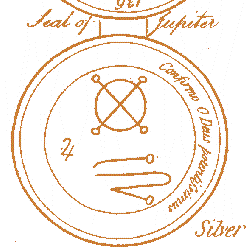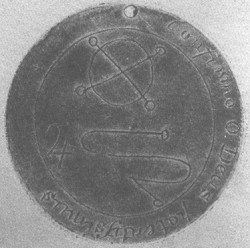thews wrote:...
This "proof of possession" that would absolutely place the Jupiter Talisman of Joseph Smith as belonging to him actually fits here. Do you acknowledge Joseph Smith owned a Jupiter talisman based on your concocted rules of what constitutes a fact based on reasonable doubt?
Such a coin-like object exists and was reportedly taken from the
pocket of the dead Smith. I think it is reasonable to assume that
he was the owner -- but, again, the chain of custody and the
purported facts of the case are too flimsy to hold up in a court
of law. It would be very useful if some student of history would
research some new discoveries to better pin down the ownership.
Uncle Dale wrote:So I'll rate my belief in Smith's stones at about 99.5%. I was not there to
see him use such objects, so I cannot vouch for the fact first-hand.
Why do you question the last 0.5%? Based on what?
That is room for reasonable doubt -- for the possibility that new facts
will be discovered to change the conclusion either totally, or perhaps
just slightly. If the conclusion were 100%, there would be no need
to seek out any additional evidence, nor to adjust history reports.
...
I have given you all the evidence you need to formulate a reasonable answer. I cited the history of the Mormon church and you completely ignored it. Why?
I do not have a great deal of respect for the LDS "History of the Church."
My religious teachers instructed me to view it with a great deal of
suspicion, and to always confirm its assertions with added evidence.
Again, by what evidence do you base you 0.5% on?
Same as above. one day additional evidence may be uncovered, showing
that, while Smith tacitly approved the wording of the 1838 article, that
in reality no such interview ever occurred, and the words were written
by an early Mormon apologist.
Why not acknowledge the evidence I've already given you? I've run across this "strategy" before in Mormon apologists, which is to just continually ignore the facts in the hopes the opponent will give up. What about the words of Joseph Smith in the history of Joseph Smith are you discounting? What is your evidence to cast doubt acknowledging the facts presented thus far?
A reasonable investigator holds open the possibility that he/she has not
yet examined all of the possible sources for a historical conclusion.
Examining "the words of Joseph Smith in the history of Joseph Smith" is
not something I do lightly, or in a few moments' time. My method is to
trace the words back in time to their initial writing or publication, and
then to determine the circumstances under which they first appeared.
...
You are known for finding historical articles are you not? If you wish to seek the truth, all you need to look at is FairMormon which is a pro-Mormon website. If you continue to ignore the data and argue against it, it shows your agenda.
I do not have a great deal of trust in pro-Mormon websites. Unless their
presentations can be confirmed with additional evidence/sources, I generally
assume that their arguments may be faulty.
...
I agree, because Joseph Smith was a fraud. The use of his stones "for convenience" per Mormon history is absurd. There was no Urim and Thummim. Do you acknowledge this fact?
I doubt very, very much that the biblical urim and thummim were ever carried
from Palestine to the ancient Americas. Thus, I see no reason to believe that
the stones Smith reportedly possessed and used bore any special resemblance
to the historical urim and thummim. I was taught in graduate school that those
items were perhaps two flat objects which were cast like dice, to provide
different possible "yes," "no," or "no answer" responses to priestly questions.
...
I have already proven it for you, and your 10% probably is absolute hogwash.
If you wish to make such hostile
condemnations and characterizations, I suggest
that you move your discussion to one of the lower forums here.
Based on the data presented, what is it that you're using to conclude there a 90% chance multiple factors to include Mormon history is wrong? Again, are you calling Brandt Gardner and FairMormon liars?
Why add the two together and demand a response from me? Writers may
provide faulty assertions without intending to be sinful or criminal. In the
case of Bro. Gardner, I have never noticed him tell a lie. Have you?
...
I'm not understanding your point. You are the one claiming they are a "few odd books and articles" and I'm claiming it's Mormon history you're ignoring.
You evidently adhere to different standards for historical reconstructions
and personal assertions than I make use of. Is it OK with you, that some
people see/apply historical sources differently than you do?
You're "not impressed" with the history of the church... that says a lot of what you intentionally choose to ignore based on you preconceived agenda.
It is generally called the "documentary" history of the church, because it
includes a great many purported reproductions of documents, presented
in more or less chronological order. However, when we compare the various
editions of the text, we can see that it varies in ways small and large, from
the "manuscript history," to the published version in the "Times and Seasons,"
to the expanded versions in the "Deseret News" and the "Millennial Star."
My "preconceived agenda" is to avoid presuming that one of these versions
is always correct, where it varies from the other versions -- or, from, say,
the RLDS "History of the Church" -- which I grew up reading and using.
Why are you doing this? The old Mormon apologists' ploy of stating something obvious to imply you've actually made a point? You just said you are "not impressed" by the HISTORY of the church. On what ground are you claiming to make a point here by stating the obvious wrapped up in a non-question?
I am attempting to demonstrate an investigative historical methodology --
a way in which we can examine an assertion, and begin to test it's veracity.
You are not making sense. The history of the church is the actual history of the church, even though they attempt to change it. The "Urim and Thummim" was not stated in ANY Mormon history until 1833, or three years after the Book of Mormon. How can you continue to discount factual data in exchange for your gut feel without any foundation? Please explain to me why you choose to discount facts?
I was trying to show a way in which we could begin to examine assertions
which may be historically inaccurate.
In your counter argument, you only presented another piece of Joseph Smith sending henchmen off to kill a man... one I agree with.
A case can be made for Smith attempting to murder that man -- but I do
not think that the available evidence would be sufficient to convict him in
a court of law. It is compelling, but not absolutely verified and reliable.
1823 was a long time ago and there weren't video camera rolling. Again, are you claiming that Brandt Gardner is a liar? Why on earth would he make these stories up and them published on FairMormon is they weren't true? Please address the facts presented. Thanks.
I have no reason to call Bro. Gardner a liar -- however I hold open my right
to disagree with his conclusions. If he asserts that some particular conclusion
of his is 100% fact, then I might at least challenge his conclusion, and
present additional evidence to back up my own historical theories.
How about acknowledging Brandt Gardner's factual data?
Can you break it down into distinct alleged facts, that I can respond
to one at a time? It will be easier for me to deal with distinct items,
rather than a number of things all put together.
is that it? You quote one newspaper article and discount Mormon history to include the words of Joseph Smith? Is that the foundation for your argument?...
I am trying to determine your method for verifying historical information, and
for separating out obvious errors from possibly true information.
I'll present the same set of assertions from an earlier published source, and
ask you to tell me which parts are facts and which parts are not facts.

"GRIP'S"
Historical Souvenir of Seneca Falls, N.Y
HISTORICAL SOUVENIR SERIES NO. 17
SENECA FALLS, N.Y., AND VICINITY
Copyrighted [1904]
"Grip," 169 Corning Ave., Syracuse, N. Y.
(ILLUSTRATED)
[6]
The Kingdom. -- [By Harrison Chamberlain] --
This little hamlet, boastful and pretentious in the early
years of the past century, was located about two
miles west of our village. Its christening is wrapped
in mystery, some claiming that it was so called after
a man named King, who built a dam in the outlet or
in an adjoining creek and hence from King's dam
the place came to be called "The Kingdom." This
is a happy, ingenious theory but unfortunately lacks
the evidence to sustain it....
[8]
The Kingdom was also the early home of Joseph
Smith, the founder of Mormonism. and was where he
first promulgated his "inspired doctrines" and
"interpreted" the "divine word" from, the golden
plates which nobody ever saw. Just east of the
tavern and adjoining the Reamer blacksmith shop,
there stood in the fifties a small story and a half
house. I remember it very well, and can recall the
fact that the neighbors spoke of it as the house
where Joseph Smith, the founder of Mormonism,
lived for a while in the fall of 1823....
[26]
"Mormon Joe," as he was called -- Joseph Smith,
the founder of Mormonism. first made known his
"divine discovery," the "golden plates," which none
hereabouts ever saw, to some of the prominent
residents of Junius. He located at Kingdom, a mile
west of Seneca Falls, about 1821 or '22 as a general
hand for any kind of work: but engaged chiefly in
finding water with a switch carried in the hand, a
custom in those days. He came here from Pompey
and lived chiefly by his wits. From this place he
went over into the town of Fayette, about 1830, where
in April of that year he organized the first Mormon
church and baptized the first converts. Mr. Harrison
Chamberlain well remembers much told about his
personality by his father and grandfather.
Strangely he procured financial assistance from
wealthy men living hereabouts to whom he in confidence
first made known his "divine inspirations."
Some of these men sacrificed a good deal to furnish
him funds. He had with him an assistant or secretary,
Oliver Cowdery, who transcribed what Mormon Joe,
standing behind a curtain, professed to read from
the golden plates, the "inspired Word of God," as
Smith said.
He was a peculiar, odd looking man, dressed in the
plainest homespun, and rather an object of wit and
pleasantry. It was not until the fall of 1823 that he
aroused particular interest in himself. Then he claimed
that he had a singular and mysterious mission. It soon
was noised about that Smith had received some spiritual
revelation, and the place was wild to learn more about
it. Under apparently a simple and innocent manner, Smith
must have been a keen judge of human nature, understanding
well how to excite curiosity and make converts.
His earliest "baptisms" -- by immersion -- were at Silver
Creek, south of Kingdom. He then resided in the house of
Peter Whitmer, three miles south of Waterloo, where he
gathered his few followers about him and preached to them.
It was while here that Smith attracted the attention of
Brigham Young, who was then a lad, one of the five sons
of John Young, who lived in the town of Tryone, Schuyler
county. Levi Halsey says that John Young was a revolutionary
soldier from Whittingham, Windham county, Ct., who had
taken land given to the soldiers in the "military tract,"
and who finally became "a traveling tinker and mender and a
poor farmer," and that his sons spent most of their time
hunting and fishing, usually in harvest time crossing
Seneca lake to work for farmers in Romulus. That was what
brought Brigham over here when he met Smith and at once
became his follower.
UD




